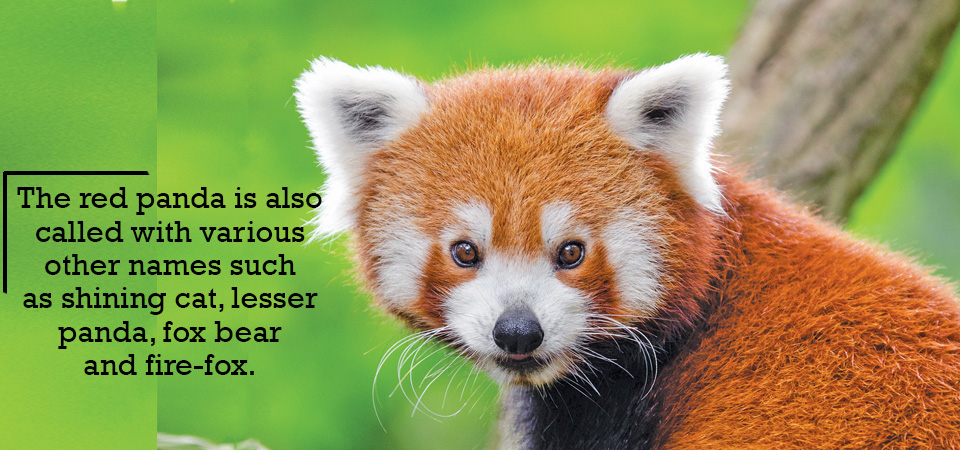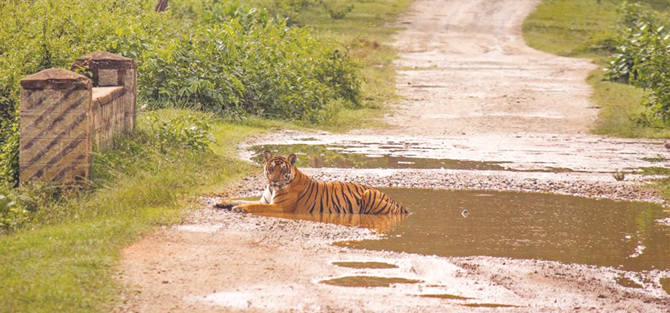Red Panda: Facing Threats Despite Conservation Efforts

Indira Aryal
Red pandas, scientifically called Ailurus fulgens and known as Habre in Nepali, are on the verge of extinction and facing threats because of their habitat destruction by over-grazing, collection of timber products, firewood and poaching.
With shy nature, a red panda is a small arboreal (living in trees) mammal and is considered one of the earth's living fossils and registered under the IUCN Red List of Threatened Species and included in Appendix I of the Convention on International Trade in Endangered Species of Wild Fauna and Flora (CITES).
A Rare Animal
They spend most of their time in trees (bamboo). They are one of the rare animal species inhabiting pleasant forests with a large number of bamboos. They mainly eat leaves and bamboo and occasionally snack on fruit, insects, birds and small lizards.
According to the National Red Panda Survey 2016, there are around 1,000 Red Pandas in Nepal and the number is less than 10,000 in the world. The red panda is also called with various other names such as shining cat, lesser panda, fox bear and fire-fox.
The word panda is derived from a Nepali dialect word nigalya ponya. Nigalya is thought to come from nigalo, meaning bamboo, but the source of ponya is less certain, although it may come from ponja meaning the ball of the foot or claws - making the complete meaning ‘bamboo foot’, various sources revealed.
They spend most of their time alone, except during the mating season and when the mother is with her cubs. Most of the time, they spend on foraging and sleeping on tree branches or in tree hollows during the day, according to a research ‘Ecology and conservation of the red panda in the Nepal Himalayas’ by late Dr Prahlad Yonzon in 1991.
Red pandas were first studied by the late Dr Yonzon in Langtang National Park from 1986 to 87. His research found mortality in adults and young people was associated with disturbances from chauri grazing and other human-related activities.
As the animal is categorised under the Red Listed Species, the government has formulated the “Red Panda Conservation Action Plan for Nepal (2019-2023)”.
The Action Plan aims to protect and manage red panda populations in Nepal, which will be achieved through a holistic approach to conservation including research, monitoring, awareness building, habitat improvement and threat management.
The National Parks and Wildlife Conservation Act-1973 has also categorised Red Panda as a protected species of Nepal, however, despite being a protected species, activities such as livestock grazing, illegal trade, poaching, habitat loss and degradation are becoming threats for their long term survival of the species.
The red panda has been reported from Rara National Park (RNP), Shey Phoksundo National Park (SPNP), Langtang National Park (LNP), Sagarmatha National Park (SNP), Makalu Barun National Park (MBNP), Dhorpatan Hunting Reserve (DHR), Annapurna Conservation Area (ACA), Manaslu Conservation Area (MCA), Gaurishankar Conservation Area (GCA) and Kanchenjunga Conservation Area (KCA). Besides Nepal, the animal is found in the mountainous regions of India, China, Bhutan, Myanmar and Laos.
Almost 70 per cent of the total habitat of Red Panda lies outside the protected areas in Nepal. Most of these habitats have been managed as the Community forest and Government managed forest.
Life cycle
Red panda breeds in the late winter months, from January to March, and the cubs are born during the monsoon, from June to August. They normally have their nests in a hollow tree or a rock crevice. Red panda gives birth to one to four blind cubs with an average clutch size of two cubs, each weighing 110 to 130 gm. They start to venture out of the nest when they are three months old. The young one leaves the mother at about eight months of age when the mother begins a new breeding season. Young people become sexually mature at 18 to 20 months of age and give first birth at 24 to 26 months after 135 days of gestation period.
Habitat loss, degradation and fragmentation along with poaching and illegal trade are the most pressing anthropogenic threats to red panda conservation. The lack of awareness, unsustainable developmental activities, dog predation, bamboo die-off, climate change and the transfer of diseases from livestock to dogs are some other threats to red panda survival, the Action Plan clarified.
According to WWF, Red panda habitat is in decline. With the loss of nesting trees and bamboo in the Eastern Himalayas, the location of almost 50 per cent of the red panda’s habitat is causing a decline in red panda populations across much of their range.
Since the 1980s, red panda focused researches and conservation interventions have been taking place in Nepal. One of the first radio-collaring studies on red pandas was carried out in the late 1980s by the late Dr Yonzon at Langtang National Park.
The first national survey of this species was carried out in 2016. In addition, community-based red panda focused conservation initiatives are being carried out in the country. Remoteness, inaccessibility to red panda habitats, inadequate law enforcement, executive summary insufficient incentives and livelihood opportunities for local communities are the main conservation challenges for this species.
Two Species Revealed
Earlier Red Panda was categorised into one species, but lately, scientists have classified the endangered Himalaya-endemic mammal into two subspecies – the Himalayan red panda (A. fulgens) and the Chinese red panda (Ailurus styani) – based on differences in morphology and biogeography, Arjun Thapa, a PhD scholar on Red Panda informed citing research on “Genomic evidence for two phylogenetic species and long-term population bottlenecks in red pandas.”.
A team of researchers from the Chinese Academy of Sciences revealed the fact based on DNA evidence. The researchers had conducted the whole genomic analysis of a total of 65 red pandas before concluding that these red pandas were two different species. Himalayan red pandas found in Nepal are a different species than Chinese red pandas,
This is the first comprehensive genetic evidence for species divergence in red pandas, demonstrating substantial inter-species genetic divergence of Red Panda.
The study showed that Himalayan red pandas are found in Nepal, Bhutan, northern India, northern Myanmar, and Tibet and western Yunnan Province of China whereas Chinese red pandas are found in Yunnan and Sichuan provinces of China.
Initiation of conservation
Red Panda Network (RPN) is continuously working on Red Panda conservation in collaboration with local stakeholders, including Community Forest Users Groups (CFUGs) and Forests Groups. Two anti-poaching networks have also been formed in western Nepal. The team patrol red panda habitats, remove traps and snares, educate locals on the importance of red panda conservation, and report poaching activity to enforcement agencies, Sonam Tashi Lama, Programme Coordinator at RNP said.
In 2019, RPN initiated Nepal’s first GPS-collaring project for red pandas. The network successfully equipped ten wild red pandas with GPS-satellite collars to study the activities of Red Panda in Ilam.
The years 2020 and 2021 have been the worst in terms of wildfires in Nepal. Massive wildfires have turned hundreds of hectares of the high mountain forest into ashes, where red pandas live, according to the RPN.
The diverse topography, altitudinal and climatic variation provides suitable habitat for an extraordinary diversity of wildlife in Nepal. Red Panda is such a wildlife species that is adapted primarily in temperate forests with abundant bamboo in the understory. Our government has prioritised the conservation of threatened species including Red Panda through the endorsement of species-specific conservation action plans. The red panda is a shy, solitary, elusive and arboreal animal with a body size similar to that of a domestic cat.
This unique animal has a tail length equal to its body length. The copper-coloured/reddish-orange glow of the coat provides good camouflage in the environment of a temperate broad-leaf forest. Because of this vibrant colour, it is also nicknamed "firefox".
A Mascot
Since 2004, it has been the mascot of Mozilla Firefox Internet Explorer. This helped to bring red pandas into the mainstream public eye as they were not widely known until then. They only started to get global attention much later after 2010.
Also, because of their cute appearance, live red pandas are often smuggled into the black market for the pet trade. But the majority of people are unaware that they have very sharp claws to climb trees and when they get slightly aggressive these claws can cause mild to severe bruises on the skin. Thus, a red panda is a bad option for a pet.
Moreover, it has an average lifespan of eight years in the wild and usually gives birth to a litter of two cubs in a year after reaching the reproductive age of 18 months. And there is a low chance of those offspring surviving in the wild because of the above-mentioned threats coupled with the low birth rate. This gravely pushes this species into the huge risk of extinction.
If a red panda is killed, poached, possessed, transported or illegally traded, one gets a hefty penalty of up to one million rupees or up to 15 years of imprisonment or both, according to the National Parks and Wildlife Conservation Act 1973. Along with that, the confusion regarding species classification and distribution should be quickly addressed. Therefore, addressing the conservation threats for red pandas’ long-term survival is very important.
(Aryal works at this daily)
Recent News

Do not make expressions casting dout on election: EC
14 Apr, 2022
CM Bhatta says may New Year 2079 BS inspire positive thinking
14 Apr, 2022
Three new cases, 44 recoveries in 24 hours
14 Apr, 2022
689 climbers of 84 teams so far acquire permits for climbing various peaks this spring season
14 Apr, 2022
How the rising cost of living crisis is impacting Nepal
14 Apr, 2022
US military confirms an interstellar meteor collided with Earth
14 Apr, 2022
Valneva Covid vaccine approved for use in UK
14 Apr, 2022
Chair Prachanda highlights need of unity among Maoist, Communist forces
14 Apr, 2022
Ranbir Kapoor and Alia Bhatt: Bollywood toasts star couple on wedding
14 Apr, 2022
President Bhandari confers decorations (Photo Feature)
14 Apr, 2022









